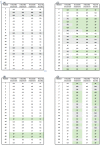Efficacy and Safety of Pulse Intravenous Methylprednisolone in Pediatric Epileptic Encephalopathies: Timing and Networks Consideration
- PMID: 38731025
- PMCID: PMC11084200
- DOI: 10.3390/jcm13092497
Efficacy and Safety of Pulse Intravenous Methylprednisolone in Pediatric Epileptic Encephalopathies: Timing and Networks Consideration
Abstract
Background: Epileptic encephalopathies (EE) are characterized by severe drug-resistant seizures, early onset, and unfavorable developmental outcomes. This article discusses the use of intravenous methylprednisolone (IVMP) pulse therapy in pediatric patients with EE to evaluate its efficacy and tolerability. Methods: This is a retrospective study from 2020 to 2023. Inclusion criteria were ≤18 years at the time of IVMP pulse therapy and at least 6 months of follow-up. Efficacy and outcome, defined as seizure reduction > 50% (responder rate), were evaluated at 6 and 9 months of therapy, and 6 months after therapy suspension; quality of life (QoL) was also assessed. Variables predicting positive post-IVMP outcomes were identified using statistical analysis. Results: The study included 21 patients, with a responder rate of 85.7% at 6 and 9 months of therapy, and 80.9% at 6 months after therapy suspension. Variables significantly predicting favorable outcome were etiology (p = 0.0475) and epilepsy type (p = 0.0475), with the best outcome achieved in patients with genetic epilepsy and those with encephalopathy related to electrical status epilepticus during slow-wave sleep (ESES). All patients evidenced improvements in QoL at the last follow-up, with no relevant adverse events reported. Conclusions: Our study confirmed the efficacy and high tolerability of IVMP pulse therapy in pediatric patients with EE. Genetic epilepsy and ESES were positive predictors of a favorable clinical outcome. QOL, EEG tracing, and postural-motor development showed an improving trend as well. IVMP pulse therapy should be considered earlier in patients with EE.
Keywords: childhood epilepsy; epileptic encephalopathy; methylprednisolone; pulse therapy.
Conflict of interest statement
The authors declare no conflicts of interest.
Figures

References
-
- Berg A.T., Berkovic S.F., Brodie M.J., Buchhalter J., Cross J.H., van Emde Boas W., Engel J., French J., Glauser T.A., Mathern G.W., et al. Revised terminology and concepts for organization of seizures and epilepsies: Report of the ILAE Commission on Classification and Terminology, 2005–2009. Epilepsia. 2010;51:676–685. doi: 10.1111/j.1528-1167.2010.02522.x. - DOI - PubMed
LinkOut - more resources
Full Text Sources

